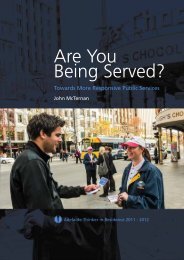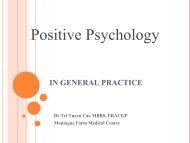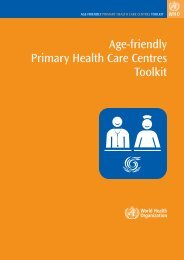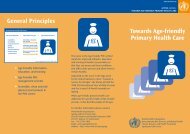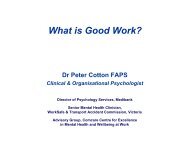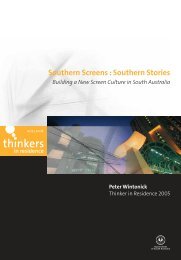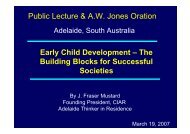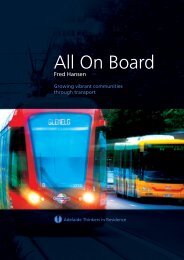Download pdf of Fred Hansen's report - Adelaide Thinkers in ...
Download pdf of Fred Hansen's report - Adelaide Thinkers in ...
Download pdf of Fred Hansen's report - Adelaide Thinkers in ...
- No tags were found...
You also want an ePaper? Increase the reach of your titles
YUMPU automatically turns print PDFs into web optimized ePapers that Google loves.
‘... the last 70 years<strong>of</strong> development hasnot been pedestrianfriendly ... ‘5. HealthycommunitiesAs noted <strong>in</strong> section 3, mak<strong>in</strong>g neighbourhoods walkable has manybenefits. In this section I will focus on one <strong>of</strong> the most critical <strong>of</strong> thosebenefits: how walkable neighbourhoods affect our health.The fact that so much <strong>of</strong> our last 70 years <strong>of</strong> development has notbeen pedestrian friendly means that we do much less walk<strong>in</strong>g thanprevious generations. The lower level <strong>of</strong> walk<strong>in</strong>g shows up <strong>in</strong> ourwaistl<strong>in</strong>es.Record obesity rates <strong>in</strong> the developed world underscore not only thefats, high calories and the volume <strong>of</strong> what we eat, but also that wedon’t get enough exercise. The health effects also show up <strong>in</strong> greater<strong>in</strong>cidences <strong>of</strong> heart disease, high blood pressure, high cholesterol,diabetes and other health problems. 9H E A L T H Y C O M M U N I T I E SHere <strong>in</strong> Australia the statistics are sober<strong>in</strong>g. In 2007 Australiaregistered the fourth highest obesity rates <strong>in</strong> the developed world,beh<strong>in</strong>d only the United States, Mexico and New Zealand. Someare predict<strong>in</strong>g that <strong>in</strong> the four years s<strong>in</strong>ce the 2007 statistics werecompiled Australia has moved higher <strong>in</strong> the rank<strong>in</strong>gs. Of moreparticular concern is South Australia, where the number <strong>of</strong> peopleeither obese or overweight (measured by BMI) is 61.6% comparedto a national average <strong>of</strong> 54.9%. A part <strong>of</strong> the reason for that higherpercentage can be seen when one looks at the sedentary behaviour: <strong>in</strong>South Australia 76.6% <strong>of</strong> the population <strong>report</strong>s hav<strong>in</strong>g low levels <strong>of</strong>exercise, compared to 72% for Australia as a whole.As our longevity <strong>in</strong>creases we are f<strong>in</strong>d<strong>in</strong>g that the debilitat<strong>in</strong>g effects<strong>of</strong> this sedentary lifestyle cause even higher levels <strong>of</strong> frustration <strong>in</strong>our senior populations as they are forced to live a more conf<strong>in</strong>ed andless active life. Activities they use to consider rout<strong>in</strong>e are becom<strong>in</strong>gmore challeng<strong>in</strong>g. The places they live <strong>of</strong>ten do not allow them to getnecessary physical activity. It is <strong>in</strong>deed a sad commentary that one <strong>of</strong>the places many seniors go to walk is shopp<strong>in</strong>g malls to which theymust drive.Excellent work has been done by the Heart Foundation <strong>of</strong> Australia,look<strong>in</strong>g at all aspects <strong>of</strong> the healthy outcomes from more walk<strong>in</strong>g.Their position statement entitled ‘The Built Environment and Walk<strong>in</strong>g’(2009) 10 is a wonderful compendium <strong>of</strong> <strong>in</strong>formation on the reasons for9OECD Health Data 2009, Statistics and Indicators for 30 countries10The built environment and walk<strong>in</strong>g - position statement, The Heart Foundation’sNational Physical Activity Advisory Committee writ<strong>in</strong>g group, 200936 FRED HANSEN: ALL ON BOARDFRED HANSEN: ALL ON BOARD 37




